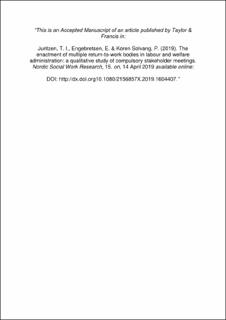The enactment of multiple return-to-work bodies in labour and welfare administration: a qualitative study of compulsory stakeholder meetings
Peer reviewed, Journal article
Accepted version
Permanent lenke
https://hdl.handle.net/11250/2646003Utgivelsesdato
2019Metadata
Vis full innførselSamlinger
Sammendrag
This article explores how caseworkers in a Scandinavian street-levellabour and welfare administration run their return-to-work program.Observations and interviews from compulsory meetings between thewelfare administration, the person on sick leave, the employer and thesick-listing GP are analysed. The analysis draws on the philosopherAnnemarie Mol’s theory of multiple bodily enactments and rendersvisible how the stakeholders enact different bodies and how thesebodies are negotiated and coordinated to make sure that they arehandling the same situation and condition. Four bodies are enacted inthe meetings: a suffering body, a diagnosed body, a working body andan active body. An in-depth analysis of selected cases demonstrates thenegotiations that take place between the individual, the workplace andthe health and welfare institutions based on their interests and under-standings. The analytical approach of this article is founded on Mol’stheoretical approach on multiple bodily enactment and the translation ofit from the hospital setting into the predominantly linguistic practices ofthe welfare administration. The aim is to broaden the understanding ofdialogical practices in this type of meeting and to expand the knowledgebase of professional work in return-to-work processes–processes whichare often confused by unclear roles and responsibilities.
